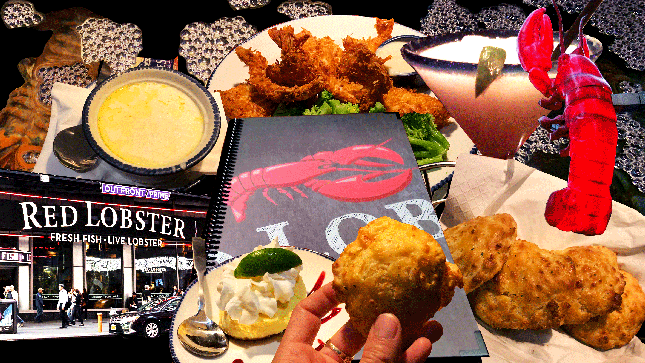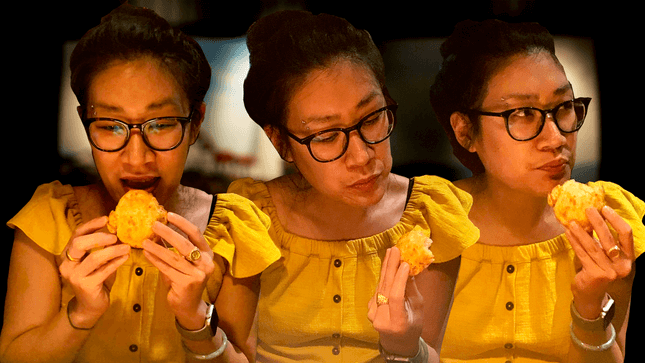
Illustration: Elena Scotti
When I turned 16, my entire family forgot that it was my birthday. It’s funny to me now in the way that all nominally tragic events are funny from a distance, but as a teenager who had internalized how important that specific age was, I was devastated, and let my family know it. “Do you want to go to Red Lobster? Or Olive Garden?” my mom tentatively asked me, after I had dramatically informed everyone that yes, I had Turned Sixteen, with nary a person marking the occasion.
We had never been to either restaurant. We rarely went to non-fast food chains, given their cost (we were a family of seven, nine if my grandparents came with us) and, in my mom’s opinion, their lackluster food. In fact, the only one we ever frequented was Golden Corral, a buffet we loved 1) because it was a buffet and 2) for its sweet rolls, which were so good that my mom would wrap as many as she could in a napkin and discreetly put them in her purse each time we visited.
I suspect that she felt the marking of what to her must have seemed like a very American tradition—a sweet sixteen!—should rightly happen at a very American restaurant, one with pretensions to grandeur. And is there a casual dining restaurant more seared in our collective imagination than Red Lobster? Okay, there probably is, but go along with me, anyway—just for a moment. As a kid growing up in a strip mall-filled part of town, and with classmates whose families would casually go to Outback Steakhouse or Red Lobster for a weekday dinner while I was stuck at home making Hamburger Helper for my two younger brothers, my parents absent due to their working long hours, believe me when I tell you I yearned to sit down and say, “I’ll have the Ultimate Feast, please.”
I yearned to sit down and say, “I’ll have the Ultimate Feast, please.”
All this to say that dining at places like Red Lobster and restaurants of its ilk has always stood in my mind for a sort of middle-class, comfortable respectability—which is, of course, exactly what their executives schemed up in their C-suites. (You got me good, Red Lobster.) Crab! Lobster! For the masses! Cheddar Bay Biscuits! Endless Shrimp®! Endless, just like the bounty of America!
Today, of course, Red Lobster is more known for being Beyoncé’s treat of choice for her man after a good fuck, where I suspect she orders a whole plateful of biscuits because she understands the universal truth that all one wants after a sweaty sex marathon is a carb overload.
But you can understand why, when our editor-in-chief asked what restaurant I wanted to review for our Welcome to the Neighborhood series, I immediately shrieked, Red Lobster!!! As an adult, the allure of Red Lobster has faded somewhat, but inside me still lives the ghost of that annoying teenager who wanted nothing more than to be like everyone else in my neighborhood. And that ghost wanted a shit ton of Cheddar Bay Biscuits.
A “surprising” “fact” I have learned about Red Lobster is that its origins are not in Maine. The first outpost was not a much-beloved seafood restaurant in Bar Harbor that then became so popular its owner expanded beyond its initial confines, all with the goal of bringing Cheddar Bay Biscuits to the American public. Contrary to all of the lighthouse-filled artwork and maritime flags behind glass that dot the walls, Red Lobster was the brainchild of two Florida residents, Bill Darden and Charley Woodsby. The pair sold the Red Lobster brand to General Mills in 1970, which then turned it into the chain we know today, marketed as a family-friendly dining option—fancier than a McDonald’s without quite breaking the bank.
After selling off Red Lobster, Woodsby opened another series of restaurants but seems today to be most passionate about Jesus. Darden, who died in 1994, seemed like a good dude, having opened a lunch counter in Waycross, Georgia in the 1930s that refused to segregate its customers. Which is why it’s extremely unfortunate that the restaurant group that now bears his name (in 1995, General Mills spun off its restaurant business, which by then included Olive Garden, and renamed it Darden Restaurants) has become fairly notorious for some serious labor violations; according to the Restaurant Opportunities Center, between 2005 and 2016, “Darden has paid over $14 million to settle lawsuits from servers around wage and hour violations at Olive Garden and Red Lobster.” Bill Darden, wherever he is, is not happy!
-

-

-

-

-

-

-

-

-

-

-

-

-

-

-

-

-

-

-

-

-

-

-

-

-

-

-

-

-

-

-

-

-

-

-

-

-

-

-

-









































